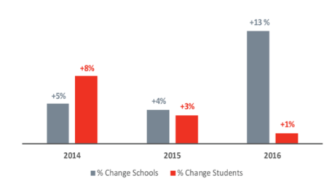Editor’s note: The number of international students studying in U.S. high schools has grown exponentially over the past ten years. Today, 2,800 high schools across all 50 states and the District of Columbia enroll nearly 82,000 students from abroad. Christine Farrugia, Ph.D., Deputy Head of Research at the Institute of International Education, shares some key insights to help U.S. schools organize study opportunities for international students.
by guest blogger Christine Farrugia
Only 15 percent of U.S. students who receive a bachelor’s degree study abroad before they graduate. Given this low rate, the presence of international students in our schools provides meaningful opportunities for U.S. students to be exposed to global perspectives and develop friendships that they may not have had otherwise. Providing the opportunity for all students to learn and grow with others from another country is an essential component of how schools can develop responsible citizens able to contribute to solving shared global challenges and compete in the global workforce.
To be successful, international programs at U.S. schools require an understanding of the global market for U.S. high school education and the needs and desires of students and their families. Here are the top four insights for schools that may be considering launching or expanding programs for international students from our recent research report “Globally Mobile Youth"**:
- International students see U.S. high schools as a pathway to U.S. higher education. The growth in U.S. secondary school enrollment by international students has been driven by those who see U.S. secondary education as a way to improve their chances of gaining admission to a U.S. college or university. In fall 2016, 72 percent of international students enrolled directly in a high school on an F-1 visa which allows foreigners to study full-time in the U.S., and many of these students seek to earn a U.S. high school diploma. Just 28 percent studied in the United States through a cultural exchange program on a J-1 visa that allows students to study at an American secondary school for a short time and then return to their home countries to complete their studies.

Figure 1. Diploma-seeking (F-1) and exchange students (J-1) at the secondary level, 2013-2016
- More students and more schools. The number of diploma-seeking international high school students in the United States more than tripled from 2004 to 2016. While this growth has continued over the past several years, the annual rate of growth has decreased more recently, suggesting that the market for international secondary students may be slowing. In 2014, the number of students increased by 8 percent from the prior year. This growth rate slowed to 3 percent in 2015 and 1 percent in 2016. At the same time that international student enrollment seems to be slowing, a growing number of U.S. high schools have become active hosts to international students. The number of U.S. schools enrolling international students grew from 2,300 in 2013 to 2,800 in 2016, representing a 26 percent growth in host schools. This growth in host schools outpaces the 12 percent growth in students over the same three-year period, suggesting that schools may face more competition to enroll international students because student demand, while still expanding, has been growing more slowly than the number of host institutions.

Figure 2. Annual change in international secondary students and host schools, 2014—2016.
- China leads. About 69 percent of international students seeking diplomas at U.S. high schools are from East Asia—primarily from China and South Korea. There are much smaller numbers of diploma-seeking high school students from Latin America and Europe and hardly any from Sub-Saharan Africa or the Middle East. This limited diversity in student demand means limited diversity in the international student population in U.S. schools. Students’ economic diversity is also limited, with most coming from families with the means to pay for their children’s education abroad.

Figure 3. Leading Places of Origin of F-1 Secondary Students, 2013-2016
- Private schools are the most active internationally. Private high schools are the most active sector for international secondary student mobility. Just over 94 percent of F-1 diploma-seeking students enroll in private high schools, a proportion that has remained fairly consistent from 2013 to 2016 (95 versus 94 percent). Religiously-affiliated private schools are the largest hosts, enrolling 58 percent of all international secondary students.
The international education landscape is changing at all levels, including in U.S. secondary schools. As more high schools are becoming interested in welcoming international students, the market for those students seeking to earn U.S. high school diplomas may be approaching a peak. To address these concerns, some schools are adopting innovative models to capture international student interest in many forms, including international summer programs, dual enrollment agreements, and serving as pathway programs for partner higher education institutions. With expanding options for students and increased institutional partnerships, steady enrollments are likely in the near future.
Connect with Christine, IIE, Heather, and Asia Society on Twitter.
All images courtesy of and used with permission of IIE.





